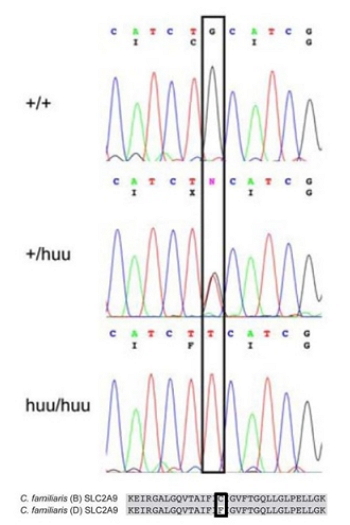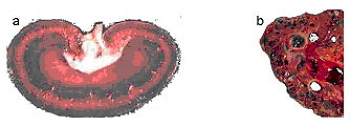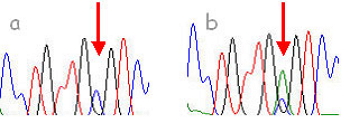DIAGNOSIS OF HEREDITARY PATHOLOGY IN THE CANINE AND FELINE SPECIES
|
Description |

Hyperuricosuria and hyperuricemia. Nucleotide sequence of a healthy dog (+/+), a cross with a Dalmatian (+/huu) and a Dalmatian (huu/huu). Below, it is shown the protein sequence with the altered amino acid cysteine (C) to phenylalanine (F) (Bannasch et al. 2008).
Some diseases related with specific canine and feline breeds are often considered as genetic pathologies, since one of the indirect effects of selecting by the aesthetic appearance of the breeds is the significant reduction of genetic diversity, resulting in the prevalence of specific diseases in a particular breed. This, together with the inadequate crossing practices and the insufficient selective pressure to characters of health and wellness, has made certain breeds especially susceptible to a large number of disorders, many of which are painful or cause a chronic weakness.
Some examples can be the Hyperuricosuria and Hyperuricemia (HUU) in the dog, and polycystic kidney disease (APKD) in the cat. HUU is a disease that produces high levels of uric acid in blood and urine due to an inefficient transport of this acid in both liver and kidney proximal tubules, which predisposes to urate urolithiasis.
The HUU is an autosomal recessive disorder which responsible mutation is a nucleotide substitution leading to a change in the protein encoded by the SLC2A9 gene, a urate transporter. The mutation, identified in Dalmatians, is also present in other breeds of dogs, many without recent phylogenetic relationship with dalmatian, indicating that this mutation had to be present in a common ancestor of all these breeds.
Mutated allele frequency ranges from 0.001 to 0.15 in breeds: American Staffordshire Terrier, Australian Shepherd, German Shepherd, Giant Schnauzer, Jack Russell Terrier, Labrador Retriever, Large Munsterlander, Pomerania, Boerboel South African, and Weimaraner.
In cats, polycystic kidney (APKD) is an autosomal, dominant and inherited disease that affects some cat breeds: Persian, exotic... It has been identified a mutation in PKD1 gene that produces an alteration in the encoded protein. This abnormal protein, at the same time, causes the appearance of a kidney cysts ending leading to a renal insufficiency, in many cases, incompatible with the animal life.
The molecular diagnosis of diseases allows the identification of animals carrying the mutation even though not having developed the disease yet. It can be done at any age of the animal and the result is valid for life.
|
How does it work |

Image of a kidney from a healthy cat (a) and a kidney from a cat died of renal insufficiency caused by polycystic kidney disease (b).
The molecular analysis of mutations-carrying genes that cause hereditary diseases can be performed from any sample containing nucleated cells. The procedure is as follows: first we carry out a DNA isolation and next we perform an enzymatic amplification of the gene by the PCR technique. The identification of the presence or absence of the mutation lets you know if the animal is free or carries the mutation that causes the disease.
|
Advantages |

Electropherogram of the PKD1 gene sequence, (a) healthy animal, (b) animal. The arrows show the position of the sequence where it is located the possible mutation.
The molecular diagnosis of hereditary diseases in both canine and feline species allows, from a small biological sample (just a drop of blood or a swab of the oral mucous membrane), an early identification of carrier animals, before they develop the disease, avoiding them to be used as breeding animals, and therefore, helping to eradicate this important disease.
The probability of identifying both the normal gene and the mutated gene is over 99%.
|
Where has it been developed |
The molecular technique for the diagnosis of polycystic kidney disease has been developed by the Genetic Service of the Faculty of Veterinary Medicine of the Complutense University of Madrid. This center has been offering its services since 1996.
In connection with this pathology, we maintain collaborations with canine and feline associations, such as the Feline Club of Madrid and the Spanish Feline Association (ASFE).
The technological basis of this Genetic Service is supported by the research that the authors have conducted over the past 20 years and spread through numerous scientific publications in relevant journals, counting also with extensive experience in collaborations with companies and associations. We are part of the group "Animal Nutrigenomics" of the Animal Production Department, Faculty of Veterinary Medicine, of the UCM, directed by Susana Dunner. This research group is included in the cluster of Agri-food and Health of the International Excellence Campus (CEI-Moncloa).
[More information about the department and research group]
|
And also |
The Genetic Service of the Veterinary Medicine Faculty of Madrid, offers support to daily veterinary activities (paternity testing, genetic identification, sexing birds by molecular techniques, diagnosis of carriers of hereditary diseases ...) and to other professionals for other purposes (genetic evaluation, estimation of genetic parameters, etc.).
The knowledge that we are having about the genomes of species of domestic animals, allows us to identify a significant number of genes that can be used in many applications of interest include, for example, the choice of free broodstock genes responsible for inherited diseases or carriers of certain genes that result in a desired strain.
|
Contact |
|
© Office for the Transfer of Research Results – UCM |
|
Descargas PDF |
|
Classification |
|
Responsible Researcher |
Javier Cañón Ferreras: genetica@vet.ucm.es
Department: Animal Production
Faculty: Veterinary Medicine


